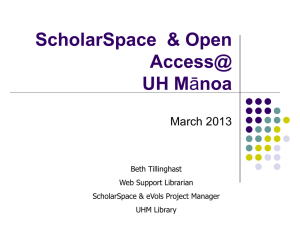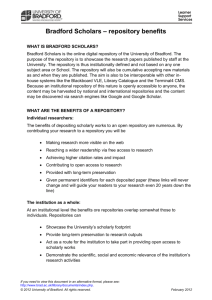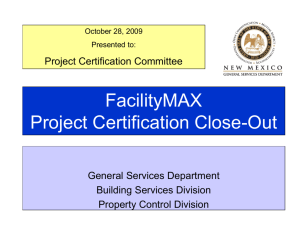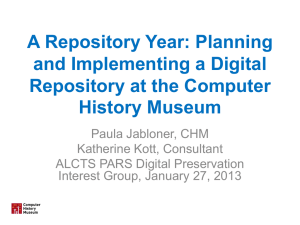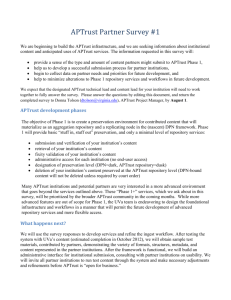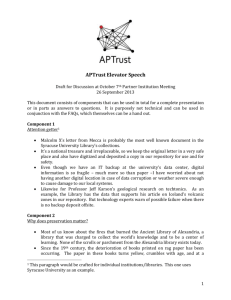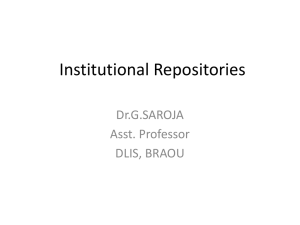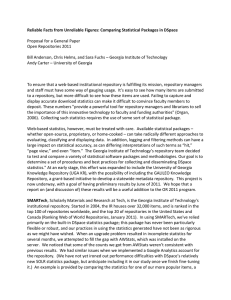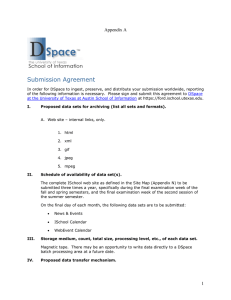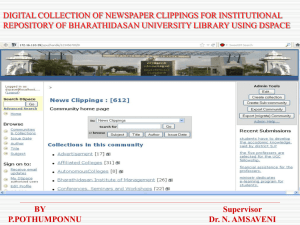building+institutional+support
advertisement
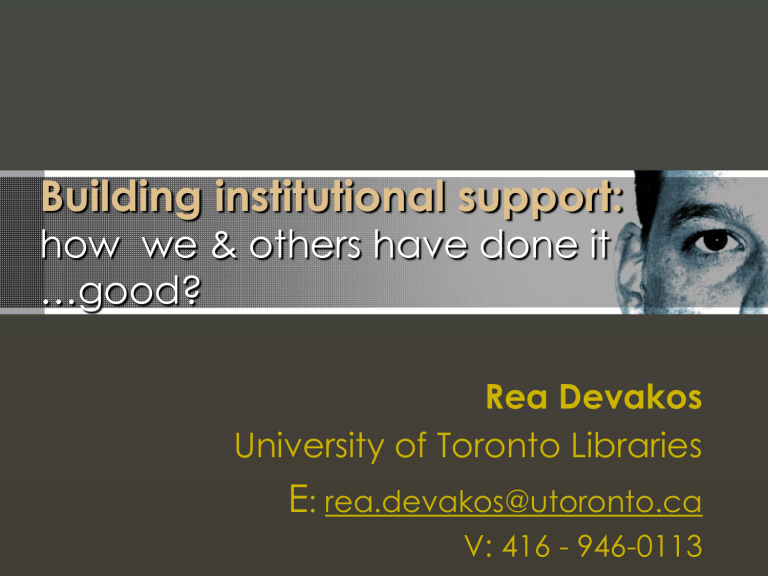
Building institutional support: how we & others have done it …good? Rea Devakos University of Toronto Libraries E: rea.devakos@utoronto.ca V: 416 - 946-0113 Agenda • Context • What others have done • Stakeholder analysis lite… • U of T’s approach 2 Tie support with purpose.. • Philosophical – Shift in scholarly communication – Open access • Web • (Pricing) crisis in scholarly publishing – Digital preservation • Practical – Proliferation of websites – One place to look – Institutional visibility and prestige 4 Of specific interest.. • Open access • “Easy” digital library • Grey literature • Theses • Publishing • Journals 5 Thinking beyond the technology The software platform is but one essential step to creating an institutional repository. Perhaps more important is identifying an appropriate implementation model. There are nearly as many models as there are institutional repositories Tenant LJ 9/15/2002 6 Organizational embedding • Administrative structure(s) – Task forces – Committees •New •Existing – Working groups • Reporting to – Joint venture – IT – Cataloging etc.. 7 8 KU ScholarWorks Working Groups Leadership Promotion Training Early Adopters Policy Standards System Implementation Access & Rights Management Collaboration of U of Kansas Library and IT staff 9 10 11 12 Stakeholders • Within the organization – – – – Faculty Senior Administration Administrative staff IT staff • Inside the library – – – – Chief Librarian Senior management Rank and file Units of interest: archives, cataloging.. 13 Strategic Thinking vs. Planning • Strengths • Weaknesses • Opportunities – Critical needs • Threats 14 Technology simple, people not.. The movement is new and the time it takes to plan, formulate policies, and bring institutional communities to consensus can make it a slow process. Drake http://www.infotoday.com/searcher/may04/ drake.shtml 15 T-Space’s Purpose • Increasing accessibility of scholarly digital materials • Digital Preservation • Faculty outreach – Existing initiatives • Why DSpace? – Sustainable – Flexible – Reliable 16 Submissions mission critical • Many unknowns – Iterative development cycles – Be as flexible as possible • Leverage experience and resources – Modify past policy work – Use existing committees • Conservative staffing model • Tie code development to EAs 17 Immediate relevance • ..it is important to offer a service in which faculty find immediate value… • …help faculty with their current problems (i.e.. managing, distributing and preserving research and teaching materials) Smith library.cern.ch/HELPLW/9/papers/3/ 18 “Selling” by letting go • Populate the database • Community driven adoption – Emerging participation “drivers” • Interviews with EAs & influentials • Re”plan” every 2 months • Build and manage “buzz” • Build representative collections • “Easy” fixes – Look and feel – Documentation 19 (Some) early adopters 1. G8 Information Centre support 2. Knowledge Media Design Institute working papers cross pollination 3. OISE/UT (Education) “curatorial” approach 4. U of T at Scarborough exemplary faculty datasets legacy 20 Community portal 21 www.utsc.utoronto.ca/~fulthorpe/ 22 23 24 Unmet user requests Accommodating …faculty needs and perceptions — and demonstrating the relevance of an institutional repository in achieving them — must be central to content policies and implementation plans. Johnson http://www.dlib.org/dlib/novembe r02/johnson/11johnson.html 25 Responding to Users • Full text indexing • Visibility – More • Library catalog • Web search engines – Less • • • • • Some items restricted to campus • Metadata may or may not be restricted Works in progress pilot Web presence User defined submission forms Eportfolios 26 Organizational embedding • Populating database continued – Instead of vs. in addition – Beyond early adopters – Work study students • Planning process • Committee structure • Library liaisons • Creative commons license – http://www.creativecommons.ca 27 Seeding collections.. • Harvesting content from ejournals – Mine existing self archiving clauses http://www.sherpa.ac.uk/romeo.php – Build into license negotiations 28 Non-technical challenges.. • As with most change programs, the most significant challenge facing institutional repositories is the “administrative attention span” and long-term commitment to insure preservation and maintenance of the repository over time, providing the necessary confidence to enable faculty members to contribute their works to the repository http://sitemaker.umich.edu/dams/files/ etcom-2003-repositories.pdf 29 Sites • DSpace www.dspace.org • T-Space tspace.library.utoronto.ca • O-Space – information literacy learning object repository ospace.scholarsportal.info 30
